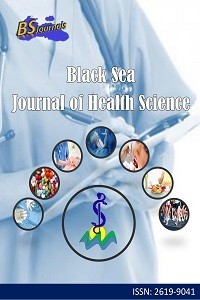Diagnostic Value of Magnetic Resonance Imaging in Evaluating Carotid Artery Atherosclerotic Plaque Morphology
Diagnostic Value of Magnetic Resonance Imaging in Evaluating Carotid Artery Atherosclerotic Plaque Morphology
___
- Bassiouny HS, Sakaguchi Y, Mikucki SA. 1997. Juxtalumenal location of plaquenecrosis and neoformation in symptomatic carotid stenosis. J Vasc Surg, 26: 585-594.
- Caliste X, Laser AR, Darling I, Cea C. 2020. Stent in patients with acute strokes: are they equally effective? J Cardiovasc Surg, 61(2):133-142.
- Chu B, Kampschulte A, Ferguson MS. 2004. Hemorrhage in the atherosclerotic carotid plaque: a high-resolution MRI study. Stroke, 35: 1079-1084.
- Edelman RR, Mattle HP, Wallner B, Bajakian R, Kleefield J, Kent C, Skillman JJ, Mendel JB, Atkinson DJ. 1990. Extracranial carotid arteries: evaluation with ‘black blood’ MR angiography. Radiology, 177: 45-50.
- Falk E. 1992. Why do plaques rupture? Circulation, 86(6): III30–III42.
- Fayad ZA. 2002. Noncoronary and coronary atherothrombotic plaque imaging and monitoring of therapy by MRI. Neuroimag Clin, 12: 461-471.
- Gronholdt ML, Nordestgaard BG, Schroeder TV. 2001. Ultrasonic echolucent carotid plaques predict future strokes. Circulation, 104: 68-73.
- Hatsukami TS, Ross R, Polissar NL, Yuan C. 2000. Visualization of fibrous cap thickness and rupture in human atherosclerotic carotid plaque in vivo with high-resolution magnetic resonance imaging. Circulation, 102: 959-964.
- Hayes CE, Mathis CM, Yuan C. 1996. Surface coil phased arrays for high resolution imaging of the carotid arteries. J Magn Reson Imag, 6: 109-112.
- Jackson MR, Chang AS, Robles HA, Gillespie DL, Olsen SB, Kaiser WJ, Goff JM, O’Donnell SD, Rich NM. 1998. Determination of 60% or greater carotid stenosis: a prospective comparison of magnetic resonance angiography and duplex ultrasound with conventional angiography. Ann Vasc Surg, 12: 236-243.
- Jianming C, Thomas S, Hatsukami S. 2005. In vivo quantitative measurement of intact fibrous cap and lipid-rich necrotic core size in atherosclerotic carotid plaque: comparison of high-resolution, contrast-enhanced magnetic resonance imaging and histology. Circulation, 112: 3437-3444.
- Kampschulte A, Ferguson MS, Kerwin WS. 2004. Differentiation of intraplaque versus juxtaluminal hemorrhage/thrombus in advanced human carotid atherosclerotic lesions by in vivo magnetic resonance imaging. Circulation, 110: 3239-3244.
- Kerwin W, Xu D, Liu F, Saam T, Underhill H, Norihide T, Chu B, Hatsukami T, Yuan C. 2007. Magnetic resonance imaging of carotid atherosclerosis plaque analysis. Top Magn Reson Imag, 18: 371-378.
- Kolodgie FD, Nakazawa G, Sangiorgi G, Ladich E, Burke AP, Virmani R. 2007. Pathology of atherosclerosis and stenting. Neuroimag Clin North America, 2007: 285-301.
- Redgrave NE, Lovett JK, Gallagher PJ. Rothwell PM. 2006. Histological assessment of 526 symptomatic carotid plaques in relation to the nature and timing of ischemic symptoms: The Oxford plaque study. Circulation, 113: 2320-2328.
- Roemer PB, Edelstein WA, Hayes CE, Souza SP, Mueller OM. 1990. The NMR phased array. Magn Reson Med, 16: 192-225.
- Rosamond W, Flegal K, Friday G. 2007. Heart disease and stroke statistics 2007 update: a report from the American Heart Association Statistics Committee and Stroke Statistics Subcommittee. Circulation, 115: 165-171.
- Saam T, Ferguson MS, Yarnykh VL. 2005. Quantitative evaluation of carotid plaque composition by in vivo MRI. Arterioscler Thromb Vasc Biol, 25: 234-239.
- Saam T, Cai J, Ma L. 2006a. Comparison of symptomatic and asymptomatic atherosclerotic carotid plaque features with in vivo MR imaging. Radiology, 240(2): 464-472.
- Saam T, Jianming C, Ma L, Cai YQ, Ferguson MS, Polissar NL, Hatsukami TS, Yuan C. 2006b. Comparison of symptomatic and asymptomatic atherosclerotic carotid plaque features with in vivo MR imaging. Radiology, 240: 464-472.
- Simonetti OP, Finn JP, White RD, Laub G, Henry DA. 1996. “Black blood” T2-weighted inversion-recovery MR imaging of the heart. Radiology, 1996: 49-57.
- Takaya N, Yuan C, Chu B. 2006. Association between carotid plaque characteristics and subsequent ischemic cerebrovascular events: a prospective assessment with MRIVinitial results. Stroke, 37: 818-823.
- Thom T, Haase N, Rosamond W. 2006. Heart disease and stroke statistics–2006 update: a report from the American Heart Association Statistics Committee and Stroke Statistics Subcommittee. Circulation, 113: e85-e151.
- Townsend TC, Saloner D, Pan XM, Rapp JH. 2003. Contrast material-enhanced MRA overestimates severity of carotid stenosis, compared with 3D time-of-flight MRA. J Vasc Surg, 38: 36-40.
- URL1: http://strokecenter.org (access date: October 07, 2019).
- Wasserman BA, Smith WI, Trout HH III, Cannon RO III, Balaban RS, Arai AE. 2002. Carotid artery atherosclerosis: in vivo morphologic characterization with gadolinium-enhanced double-oblique MR imaging initial results. Radiology, 223: 566-573.
- Yamada N, Higashi M, Otsubo R. 2007. Association between signal hyperintensity on T1-weighted MR imaging of carotid plaques and ipsilateral ischemic events. AJNR Am J Neuroradiol, 28: 287-292.
- Yuan C, Mitsumori LM, Ferguson MS. 2001. In vivo accuracy of multispectral magnetic resonance imaging for identifying lipid-rich necrotic cores and intraplaque hemorrhage in advanced human carotid plaques. Circulation, 104: 2051-2056.
- Yuan C, Zhang SX, Polissar NL. 2002. Identification of fibrous cap rupture with magnetic resonance imaging is highly associated with recent transient ischemic attack or stroke. Circulation, 105: 181-185.
- Yayın Aralığı: Yılda 4 Sayı
- Başlangıç: 2018
- Yayıncı: Cem TIRINK
Birsay GÜMRÜ, Melda Pelin AKKİTAP
Postoperatif Gelişen Hipoksi; Negatif Basınçlı Akciğer Ödemi mi? Covid-19 mu? Olgu Sunumu
Deran DALBUDAK SANSAR, Burcu YAVUNÇ YEŞİLKAYA
Nutrition Consumption Frequencies Scale of Change: Validity and Reliability Study
Burhan BAŞARAN, Hilal PEKMEZCİ PURUT
Nozokomiyal Rotavirüs Enfeksiyonları
Sevil ALKAN, Emine Kübra DİNDAR DEMİRAY, Anıl AKÇA, Taylan ÖNDER, Servan VURUCU
Retrospective Evaluation of Anesthesia Experience at a Training and Research Hospital in Turkey
Canan YILMAZ, Derya KARASU, Merve BAYTAR, Selim YIRTIMCI, Ümran KARACA, Ayşe Neslihan BALKAYA, Mehmet GAMLI
Adolesanlarda Cilt Sorunlarinin Beslenme Alişkanliği ve Duygu Kontrolü İle İlişkisi
Aliye ÖZENOĞLU, Gülay KURT, Elif REİS, Kamil ALAKUS
Perinatal Dönem Ruh Sağlığı Sorunları ve Hemşirelik Yaklaşımı
